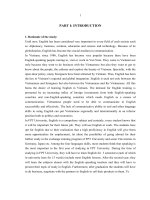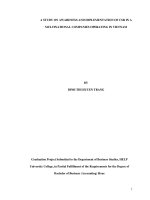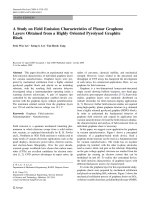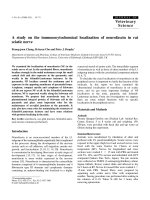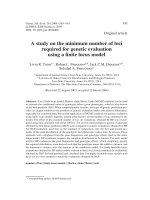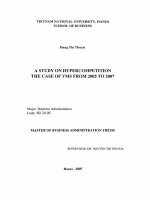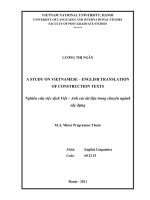A study on specialized terminology translation of maritime logistics
Bạn đang xem bản rút gọn của tài liệu. Xem và tải ngay bản đầy đủ của tài liệu tại đây (730.34 KB, 62 trang )
BỘ GIÁO DỤC VÀ ĐÀO TẠO
TRƯỜNG ĐẠI HỌC DÂN LẬP HẢI PHÒNG
-------------------------------
ISO 9001 :2008
KHÓA LUẬN TỐT NGHIỆP
NGÀNH: NGÔN NGỮ ANH
Sinh viên
: Nguyễn Quang Huy
Lớp
: Na1804
Giảng viên hướng dẫn : Ths. Đặng Thị Vân
HẢI PHÒNG - 2018
MINISTRY OF EDUCATION AND TRAINING
HAIPHONG PRIVATE UNIVERSITY
-----------------------------------
A STUDY ON SPECIALIZED TERMINOLOGY
TRANSLATION OF MARITIME LOGISTICS
GRADUATION PAPER
Student
: Nguyen Quang Huy
Class
: NA1804
Supervisor
: Dang Thi Van, M.A
HẢI PHÒNG - 2018
BỘ GIÁO DỤC VÀ ĐÀO TẠO
TRƯỜNG ĐẠI HỌC DÂN LẬP HẢI PHÒNG
--------------------------------------
NHIỆM VỤ ĐỀ TÀI TỐT NGHIỆP
Sinh viên: Nguyễn Quang Huy
Mã SV: 1412751030
Lớp: NA1804
Ngành: Ngôn Ngữ Anh
Tên đề tài: A study on specialized terminology translation of maritime
logistics.
NHIỆM VỤ ĐỀ TÀI
1. Nội dung và các yêu cầu cần giải quyết trong nhiệm vụ đề tài tốt nghiệp
( về lý luận, thực tiễn, các số liệu cần tính toán và các bản vẽ).
……………………………………………………………………………..
……………………………………………………………………………..
……………………………………………………………………………..
……………………………………………………………………………..
……………………………………………………………………………..
……………………………………………………………………………..
……………………………………………………………………………..
……………………………………………………………………………..
2. Các số liệu cần thiết để thiết kế, tính toán.
……………………………………………………………………………..
……………………………………………………………………………..
……………………………………………………………………………..
……………………………………………………………………………..
……………………………………………………………………………..
……………………………………………………………………………..
……………………………………………………………………………..
……………………………………………………………………………..
……………………………………………………………………………..
3. Địa điểm thực tập tốt nghiệp.
……………………………………………………………………………..
……………………………………………………………………………..
……………………………………………………………………………..
CÁN BỘ HƯỚNG DẪN ĐỀ TÀI TỐT NGHIỆP
Người hướng dẫn thứ nhất:
Họ và tên: Đặng Thị Vân
Học hàm, học vị: Thạc sĩ
Cơ quan công tác: Trường Đại học Dân lập Hải Phòng
Nội dung hướng dẫn: A study on specialized terminology translation of
maritime logistics
Người hướng dẫn thứ hai:
Họ và tên:.............................................................................................
Học hàm, học vị:...................................................................................
Cơ quan công tác:.................................................................................
Nội dung hướng dẫn:.................................................................. ..........
Đề tài tốt nghiệp được giao ngày 12 tháng 03 năm 2018
Yêu cầu phải hoàn thành xong trước ngày 31 tháng 05 năm 2018
Đã nhận nhiệm vụ ĐTTN
Đã giao nhiệm vụ ĐTTN
Sinh viên
Người hướng dẫn
Hải Phòng, ngày ...... tháng........năm 2018
Hiệu trưởng
GS.TS.NGƯT Trần Hữu Nghị
PHẦN NHẬN XÉT CỦA CÁN BỘ HƯỚNG DẪN
1. Tinh thần thái độ của sinh viên trong quá trình làm đề tài tốt
nghiệp:
……………………………………………………………………………..
……………………………………………………………………………..
……………………………………………………………………………..
……………………………………………………………………………..
……………………………………………………………………………..
……………………………………………………………………………..
……………………………………………………………………………..
2. Đánh giá chất lượng của khóa luận (so với nội dung yêu cầu đã đề ra
trong nhiệm vụ Đ.T. T.N trên các mặt lý luận, thực tiễn, tính toán số
liệu…):
……………………………………………………………………………..
……………………………………………………………………………..
……………………………………………………………………………..
……………………………………………………………………………..
……………………………………………………………………………..
……………………………………………………………………………..
……………………………………………………………………………..
……………………………………………………………………………..
……………………………………………………………………………..
3. Cho điểm của cán bộ hướng dẫn (ghi bằng cả số và chữ):
……………………………………………………………………………..
……………………………………………………………………………..
……………………………………………………………………………..
Hải Phòng, ngày … tháng … năm 2018
Cán bộ hướng dẫn
(Ký và ghi rõ họ tên)
NHẬN XÉT ĐÁNH GIÁ
CỦA NGƯỜI CHẤM PHẢN BIỆN ĐỀ TÀI TỐT NGHIỆP
1. Đánh giá chất lượng đề tài tốt nghiệp về các mặt thu thập và phân tích
tài liệu, số liệu ban đầu, giá trị lí luận và thực tiễn của đề tài.
...............................................................................................................................
...............................................................................................................................
...............................................................................................................................
...............................................................................................................................
...............................................................................................................................
...............................................................................................................................
...............................................................................................................................
...............................................................................................................................
...............................................................................................................................
2. Cho điểm của người chấm phản biện : ………………………..
(Điểm ghi bằng số và chữ)
Ngày.......... tháng......... năm 2018
Người chấm phản biện
ACKNOWLEDGEMENTS
First of all, I wish to express my sincere thank you to all those who have supported
me during the process of making this graduation paper.
I am extremely thankful and indebted to my thesis supervisor Ms. Dang Thi Van,
for sharing expertise, and sincere and valuable guidance extended to me.
I take this opportunity to express gratitude to the Foreign Languages Department of
Haiphong University for giving me the inspiration to carry out this graduation
paper.
Finally, I wish to thank my parents for their support and encouragement throughout
my study.
Thank you sincerely!
Haiphong, June, 2018
Nguyen Quang Huy
TABLE OF CONTENTS
PART I: INTRODUCTION ...................................................................................... 1
1. Rationale of the study............................................................................................... 1
2. Aim of the study ....................................................................................................... 1
3. Scope of the study .................................................................................................... 1
4. Method of the study ................................................................................................. 2
5. Design of the study................................................................................................... 2
PART II: DEVELOPMENT ..................................................................................... 3
CHAPTER I: THEORETICAL BACKGROUND ................................................ 3
I.1 Translation theory ................................................................................................ 3
I.1.1 Definition of translation....................................................................................... 3
I.1.2 Types of translation ............................................................................................. 4
I.1.3 Translation procedures......................................................................................... 6
I.2 English for Specific purposes in translation (ESP)........................................... 8
I.2.1 Definitions and characteristics of ESP ................................................................ 8
I.2.2 Types of ESP...................................................................................................... 10
I.3 Terminology ........................................................................................................ 13
I.3.1 Definition of terminology .................................................................................. 13
I.3.2 The distinction between term and word ............................................................ 13
I.3.3 Features of terminology ..................................................................................... 14
I.4 Non-equivalence at word level and above word level..................................... 15
I.4.1 Non-equivalence at word level .......................................................................... 15
I.4.2 Non-equivalence at above word level ............................................................... 16
I.4.3 Definition of collocation .................................................................................... 16
I.4.4 Collocational meaning and the shift of meaning in collocation. ...................... 17
CHAPTER II: A STUDY ON TRANSLATION OF MARITIME LOGISTICS
TERMINOLOGY..................................................................................................... 19
II.1 Logistics .............................................................................................................. 19
II.1.1 Definition of logistics ....................................................................................... 19
II.1.2 Maritime and logistics ...................................................................................... 19
II.1.2.1 Concept, focusing point and functions of maritime logistics:...................... 19
II.1.3 Maritime transportation .................................................................................... 20
II.1.3.1 Concept: ......................................................................................................... 20
II.1.3.2 Overview: ...................................................................................................... 20
II.2 Construction of maritime logistics terminology ............................................ 20
II.2.1 Single terms ...................................................................................................... 20
II.2.1.1 Single terminologies in form of noun formed by suffiex and prefixes ........ 20
II.2.1.2 Single terminologies in form of verb: ........................................................... 23
II.2.2 Compound terminologies ................................................................................. 23
II.2.2.1 Compound terminologies consisting of noun as classifier + thing: ............. 23
II.2.2.2 Compound terminologies consisting of adjective as classifier + thing: ...... 25
II.2.2.3 Compound terminologies consisting of present participle + noun: ............. 26
II.2.2.4 Compound terminologies consisting of past participle + noun: .................. 28
II.2.3 Neologism in maritime logistics ...................................................................... 29
II.2.3.1 Eponyms in maritime logistics ...................................................................... 29
II.2.3.2 Acronyms in maritime logistics .................................................................... 30
CHAPTER III: DIFFICULTIES AND SUGGESTED SOLUTIONS IN
TRANSLATING MARITIME LOGISTICS TERMINOLOGY ....................... 32
III.1 Difficulties in translating maritime logistics terminology .......................... 32
III.1.1 Finding the most adequate equivalent unit ..................................................... 32
III.1.2 No direct equivalence from target language to source language ................... 33
III.2 Suggested solutions in translating maritime logistics terminology ........... 34
III.2.1 Translation by omission .................................................................................. 34
III.2.2 Translation by using borrowed words ............................................................ 34
III.2.3. Translation by a collocation with similar meaning ....................................... 35
III.2.4 Transposition translation ................................................................................. 35
III.2.5 Translation by adding information ................................................................. 36
PART III: CONCLUSION...................................................................................... 38
REFERENCES ......................................................................................................... 39
APPENDIX 1: Choose the appropriate translation ............................................. 41
APPENDIX 2: Text translation .............................................................................. 44
APPENDIX 3: GLOSSARY.................................................................................... 45
PART I: INTRODUCTION
1. Rationale of the study
The process of globalization dictates higher request to a level of knowledge of
language skill. Globalization of the shipping industry and application of modern
technologies on broad vessels demand a high level of education and training. In the
world of international shipping, with seafarers from different nations sailing on
ships to all part of the world, language communication is vitally important between
those on broad and between ship and shore. Historically, English has become the
means for the communication at sea that is the reason why understanding English
terms and its Vietnamese equivalent in maritime logistics is very essential in order
to achieve the best results at sea communication. Living in a major port city of
Vietnam and having my family working traditionally in the port have inspired me to
carry out this research to further my knowledge in maritime logistics.
2. Aim of the study
The study on translation of specialized maritime logistics terminology aims to
figure out an overview on translation strategies and procedures to have an effective
understanding and communication in maritime logistics.
In details, my Graduation paper aims at:
* Collecting and presenting English terms in maritime logistics profession.
* Providing Vietnamese equivalents or expressions for its English terms in maritime
logistics profession.
* Preliminarily analyzing translation strategies and procedures employed in the
translation of English terms into their Vietnamese corresponding.
* Providing some knowledge of maritime logistics profession to students majoring
in the field.
3. Scope of the study
Maritime logistics terms are a huge professional field that requires a great amount
of time and experiences to research. Due to limitation of time and knowledge, my
1
study could not cover all aspects of this theme. On that matter, I chose to focus on
the vocabulary and knowledge of two specific aspects which are sea shipping and
port warehousing in maritime logistics as they are related to each other closely.
4. Method of the study
This Graduation paper is carried out by using the qualitative methods, which deals
in logic, and an objective stance. Qualitative research focuses on unchanging data
and detailed, convergent reasoning rather than divergent reasoning.
All of English and Vietnamese terms in this graduation paper are collected from
internet and dictionary. These data are divided into groups based on their common
character.
5. Design of the study
This Graduation paper is divided into three parts, in which the second one is the
most important part.
Part I: The rationale, aims, method, scope and design of the research are mentioned
to provide readers an overview of the research.
Part II: Mention the main content of the research and is divided into three chapters:
Chapter I: Theoretical background of translation.
Chapter II: Maritime logistics terminology.
Chapter III: Difficulties and and suggestions in translating process.
Part III: Summarize main ideas mentiond in previous parts.
2
PART II: DEVELOPMENT
CHAPTER I: THEORETICAL BACKGROUND
I.1 Translation theory
I.1.1 Definition of translation
There are many different definitions for translation as each translator, researcher,
linguist, etc. defines their own idea to understand the concept of translation. This
can be seen in most of the following definitions:
According to Brislin (1976, 1) translation is a general term referring to the transfer
of thoughts and ideas from one language to another, whether the language is in
written or oral form, whether the languages have established orthographies or not’
or whether one or both languages is based on signs, as with signs of the deaf.
Nida (1964, 3) regards translation as a scientific subject and points out that “the
transference of a message from one language to another is a valid subject for
scientific description”. In the later publication about translation theory, he proposes
the concept of dynamic equivalence and defines translation as “the closest natural
equivalent of the source-language message, first in terms of meaning and secondly
in terms of style”. (Nida, 1982, 12)
Bell, Roger T (1991, 5) claims “translation is the expression in another language (or
target language) of what has been in another, source language, preserving semantic
and stylistic equivalences”. He then also adds “translation is the replacement of a
representation of a text in one language by a representation of an equivalent text in a
second langauge”.
"Translation is a craft consisting in the attempt to replace a written message and/or
statement in one language by the same message and/or statement in another
language". (Newmark, 1981, 7)
3
“It is rendering the meaning of a text into another language in the way that the
author intended the text”. (Newmark, 1988, 5)
“The process of changing something that is written or spoken into another
language”. (Oxford Advanced Learner’s Dictionary 7 th edition, p1632)
Surjeet Singh Warwal mentions in his article that “Translation is the comprehension
of the meaning of a text and the subsequent production of an equivalent text,
likewise called a “translation” that communicates the same message in another
language. The text that is translated is called the source text, and the language that it
is translated into is called the target language.The product is sometimes called the
target text”, he then explains further by breaking down the word “translation” itself.
“Translation is the word for Greek and translation word made up two think one is.
‘Trans’+ ‘Lation’, ‘Trans’ means across, ‘Lation’ means to bring. Thus we can say
that translation is the S.L to Converted to T.L. Translation is a creative process of
reproducing the text from S.L to T.L . It is like a change one set of clothes to
another where the context is same”.
Although the above definitions are different, they have some common features
generally. To summarize, translation is a process of finding the most adequate
equivalents to convey meanings from source language to target language.
I.1.2 Types of translation
There are various methods by which the text is translated. According to Peter
Newmark (1988, 45) there are eight methods which have been put in the form of a
flattened V diagram below:
SL Emphasis
TL Emphasis
Word-for-word trans
Adaptation
Literal Translation
Free translation
Faithful Translation
Semantic Translation
Idiomatic translation
Communicative translation
(Source: New mark, 1988, 45.)
4
Word-for-word translation
This is often demonstrated as interlinear translation, with the TL immediately below
the SL words. The SL word-order is preserved and the words translated singly by
their most common meanings, out of context. Cultural words are translated literally.
The main use of word-for-word translation is either to understand the mechanics of
the source language or construe a difficult text as a pre-translation process.
Literal translation
The SL grammatical constructions are converted to their nearest TL equivalents but
the lexical words are again translated singly, out of context. As a pre-translation
process, this indicates the problems to be solved.
Faithful translation
A faithful translation attempts to reproduce the precise contextual meaning of the
original within the constraints of the TL grammatical structures. It ‘transfer’ cultural
words and preserves the degree of grammatical and lexical ‘abnormality’ (deviation
from SL norms) in the translation. It attempts to be completely faithful to the
intentions and the text-realization of the SL writer.
Semantic translation
Semantic translation differs from ‘faithful translation’ only in as far as it must take
more account of the aesthetic value (that is, the beautiful and natural sounds of the
SL text, compromising on ‘meaning’ where appropriate so that no assonance, wordplay or repetition jars in the finished version. Further, it may translate less important
cultural words by culturally neutral third or functional terms but not by cultural
equivalents. This distinction between ‘faithful’ and ‘semantic’ translation is that the
first is uncompromising and dogmatic, while the second is more flexible, admits the
creative exception to 100% fidelity and allows for the translator’s intuitive empathy
with the original.
5
Adaptation
This is the ‘freest’ form of translation. It is used mainly for plays (comedies and
poetry), the mems, characters, plots are usually preserved, the SL culture converted
to the TL culture and the text rewritten. The deplorable practice of having a play or
poem literally translated and then rewritten by an established dramatist or poet has
produced many poor adaptations, but other adaptations have ‘rescued’ period plays.
Free translation
Free translation reproduces the matter without the manner, or the content without the
form of original. Usually it is a paraphrase much longer than the original, a So-called
‘intralingual translation’, often prolix and pretentious, and not translation at all.
Idiomatic translation
Idiomatic translation reproduces the ‘message’ of the original but tends to distort
nuances of meaning by preferring colloquialism and idioms where these do not exist
in the original.
Communicative translation
Communicative translation attempts to render the exact contextual meaning of the
original in such a way that both content and language are readily acceptable and
comprehensible to the readership.
I.1.3 Translation procedures
Chesterman .A. (1989) translation procedures are methods applied by translators
when they formulate an equivalence for the purpose of transferring elements of
meaning from the Source Text to the Target Text. Jean Paul Vinay and Jean
Darbelnet in the 1950s came up with seven procedures of translation and as many
ways to attain equivalence. Vinay and Darbelnet proposed seven methods or
procedures; they are borrowing, calque, literal, transposition, modulation,
equivalence, adaptation.
6
Borrowing
Borrowing is the idea of taking the word from the source language and maintaining
it in the target language. It is considered the simplest of the procedures and tends to
be employed in two situations: either when discussing a new technical process for
which no term exists within the TL, or when maintaining a word from the SL for
stylistic effect, in which the translator uses the foreign term to add flavor to the
target text.
Calque
A calque is when an expression from the source text is transferred literally into the
target text. Calques either follow the syntax of the target language while translating
each word literally or ignore the syntax of the target language and maintain the
syntax of the target language, rendering the calque is an awkward syntactical
structure in the target text. When a translator uses a calque, he or she is creating or
using a neologism in the target language by adopting the structure of the source
language.
Literal translation
A word-for-word translation can be used in some languages and not others
dependent on the sentence structure.
Usually this is called a literal translation or metaphrase. This means a word-forword translating, achieving a text in the target language which is as correct as it is
idiomatic. According to Vinay and Darbelnet, a literal translation can only be
applied with languages which are extremely close in cultural terms. It is acceptable
only if the translated text retains the same syntax, the same meaning and the same
style as the original text.
Transposition
This is the process where parts of speech change their sequence when they are
translated. Vinay and Darbelnet referred to translation as changing word class
without changing meaning. This refers to when translators (often without thinking)
change the word type, such as from nouns to verbs. Vinay and Darbelnet considered
7
transposition to be either obligatory or optional, and referred to the ST as the base
expression and the TT as the transposed expression.
Modulation
The fifth of Vinay and Darbelnet’s procedures is modulation. Modulation refers to
rendering the TT from a different point of view to that of the ST. Vinay and
Darbelnet consider this procedure to be necessary when the results of the former
procedures would produce an awkward-sounding translation, despite it being
grammatically, syntactically, and lexically correct. Modulation is a way for the
translator to find a degree of naturalness in their TT without sacrificing any
meaning or accuracy originating from the ST.
Equivalence
The idea of equivalence can be simultaneously simple and complex in Translation
Studies, Vinay and Darbenet explain equivalence as something almost inherently
cultural, using the example of someone expressing pain. In English, the term
“ouch!” is used. While in French, a literal rendering of the sound would be of no
use to the reader. Instead, the equivalent of “ouch!” in French is “aïe”. Both words
would immediately indicate to readers that there is some level of pain involved.
Adaptation
The most complex of Vinay and Darbelnet’s translation procedures is the final one,
adaption. It is similar to equivalence in the way that the translator seeks to render
the SL into whilst ensuring it is just as relevant and meaningful as the original was.
I.2 English for Specific purposes in translation (ESP)
I.2.1 Definitions and characteristics of ESP
ESP is the abbreviation for English for Specific Purpose and it has grown to become
one of the most prominent areas of EFL teaching today. As Strevens (1988, 1)
mentions that “ESP is a particular case of the general category of special purpose
language teaching”. Defining ESP is a very different task since different researchers
have given different expression to ESP.
8
According to Strevens (1988, 1-2), a definition of ESP needs to distinguish between
four absolute and two variable characteristics:
Absolute characteristics of ESP:
ESP consists of English language teaching which is:
1. Designed to meet specific needs of the learners
2. Related in content (i.e., in its themes and topics) to particular disciplines,
occupations and activities.
3. Centered on the language appropriate to those activities, in syntax, lexis,
discourse, semantics, etc.
4. In contrast with general English (GE).
* Variable characteristics of ESP:
ESP may be, but is not necessarily:
1. Restricted as to the language skills to be learnt (e.g.: reading only, speech
recognition only, etc.)
2. Taught according to any pre-ordained methodology (i.e., ESP is not restricted to
any particular methodology – although communicative methodology is very often
felt to be the most appropriate).
To clarify the meaning of ESP, Dudley-Evans (1998, 4) gave an extended definition
in terms of “absolute” and “variable” characteristics…
*Absolute Characteristics
1. ESP is defined to meet specific needs of the learners
2. ESP makes use of underlying methodology and activities of the discipline it
serves
3. ESP is centered on the language appropriate to these activities in terms of
grammar, lexis, register, study skills, discourse and genre.
*Variable Characteristics
1. ESP may be related to or designed for specific disciplines
2. ESP may use, in specific teaching situations, a different methodology from that
of
9
3. ESP is likely to be designed for adult learners, either at a tertiary level institution
or in a professional work situation. It could, however, be for learners at secondary
school level
4. ESP is generally designed for intermediate or advanced students
5. Most ESP courses assume some basic knowledge of the language systems.
The definition Dudley-Evans (1998) offered is clearly influenced by that of
Strevens (1988), although he has improved it by removing the absolute
characteristics of that ESP is “in contrast with GE”, and has included more variable
characteristics. From the above definition, ESP does not aim at specific discipline or
at a certain group, ability range. It is rather an approach to teaching or as
Hutchinson (1987, 19) concludes “ESP is an approach to language teaching in
which all decisions as to content and method are based on the learner’s reason for
learning”. The need of knowledge will draw learners to learn what they need to
know. For an example, the students, registered for maritime logistics, are expecting
the English that is taught on a language course to be useful and relevant to their
jobs. Therefore, they take part in an English course not due to their interest but
rather its usefulness to their career. As Strevens (1988, 4) says “Tell us what you
need to learn and for what purpose. We will then design a course which teaches you
precisely that: no more or no less. And we will do so by means of highly effective
teaching methods”.
I.2.2 Types of ESP
There are many types of ESP. According to Hutchinson & Waters (1987, 18) “ESP
is just one branch of EFL (English as a Foreign Language)/ ESP, which are the
main branches of English language teaching in general”. According to the tree of
ELT (English Language Teaching) given by them (Hutchinson & Waters, 1987,
17), there are two main types of ESP: EAP (English for Academic Purposes) and
EOP/EVP/VESL (English for Occupational Purposes/ English for Vocational
Purposes/ Vocational English as a Second Language). Robinson (1991, 3) presents
two versions of the “ESP family tree”. The first version divides ESP into two
branches: EOP involving work-related needs and training and EEP (English for
Economics Purposes)/ EAP involving academic study needs (figure 1). The second
10
version divides ESP into three branches: Academic, professional and vocational
referring to both work and study-related needs (figure 2).
Pre-experience
EOP
Simultaneous/ in-service
Post-experience
ESP
Pre-study
For study in a specific
discipline
EEP/
EAP
In-study
Post-study
Independent
As a school project
Integrated
Figure 1: The ESP ‘family tree’ (Robinson, 1991, 3)
Entry level
General EAP
Lower division
Academic
Discipline specific
(Graduate level)
ESP
Professional
Business
Social
Technological
Usually done privately
Entry VESL
Vocational
Literacy
Figure 2: ESP in the USA (Robinson, 1991, 4)
11
Another typical tree diagram for ESP which divides EAP and EOP according to
discipline or professional area is presented by Dudley-Evans (1998, 6) (figure 3)
English for specific purpose
English for academic purposes
English for English for
Science and Medical
Technology Purposes
English for
Legal
Purposes
English for occupational purposes
English for
Management,
Finance and
Economics
English
for
Medical
Purposes
English for
Professional
Purposes
English
for
Business
Purposes
English for
Vocational
Purposes
PreVocational
English
Vocational
Purposes
Figure 3: ESP classification by professional area (Evans & John, 1998, 6)
English for specific Purposes, therefore, takes in two types of instruction: EOP
(English for Occupational Purposes) and EAP (English for Academic Purposes).
Course in EOP trains individual to perform on the job, using English to
communicate such as hotel staff, air hostess, etc. EAP, on the other hand, features a
common core element known oral presentation which involves the attention to the
needs of audience, careful planning and attention to delivery, learning these abilities
will enable learners to succeed in English-language academic settings. However to
distinguish these two types is rather difficult because, in Vietnam, English is taught
only as a foreign language at every university but after graduating learns may use
the language as a tool for achieving their purposes in their workplace. This
distinction, according to Hutchinson (1987, 16), is “not a clear-cut” because people
can work and study simultaneously and in many cases, the language learnt for
immediate use in a study environment will be used later when students take up, or
return to a job.
12
I.3 Terminology
I.3.1 Definition of terminology
Terminology plays an important role in the understanding of contexts and
specialized texts. Understanding the intricate terminological details of the technical
and scientific contexts helps students comprehend what the main message of the
document is, and it helps specialists transmit the content more effectively. There has
been much research about this topic and a large number of definitions have been
proposed.
According to Valeontis and Mantzari (2006, 1), Terminology has two fold
meanings: (1) It is the discipline concerned with the principles and methods
governing the study of concepts and their designations (terms, names, symbols) in
any subject field, and the job of collecting, processing, and managing relevant data
and (2) the set of terms belonging to the special language of an individual subject
field”.
In the Oxford advanced learner’s dictionary (7 th edition, 1583) it is said that
terminology is the set of technical words or expressions used in a particular field.
In brief, terminology is a set of terms that are given specific meanings in specific
contexts, each term denotes a concept of particular field such as economics, science,
biology, and so on.
I.3.2 The distinction between term and word
It is necessary to distinguish between terminology and ordinary words. As Baker
(1998) claims “term differ from words in that they are endowed a word with a
special form of reference, namely that they refer to discrete conceptual entities,
properties, activities or relations which constitute the knowledge space of a
particular field”.
According to English Oxford Advanced Dictionary (7th edition, 1758) a word is “a
single unit of language which means something and can be spoken or written”.
Term is defined as “a word or phrase used as the name of something, especially one
connected with a particular type of language: a technical/legal/scientific, etc.”.
13
Basically, they are names of concepts and subjects belonging to different
specialized fields.
In short, a term is a point of reference, whereas a word is only a constituent of
language. Hence, all terms are words, but only some words can be terms.
I.3.3 Features of terminology
There are three characteristics of terminology and they are classified namely as
accurateness, systematism and popularity.
Accurateness
A term represented a concept in particular field must be clear and exact to make
sure there is no misunderstanding and confusion for the ones receiving the terms.
In normal conversation, normal words often convey some characteristics of
polysemy and synonym. Accuracy is necessary so that people never mistake one
concept to another.
Systematism
As part of a language field, each term has its meaning, position closely related to
others reflecting a system of concept of a particular profession. The value of each
term is determined by its relationship with other terms in the system. Consequently,
a term will lose its profession when isolated from the context. For example, if “free
time” is not put in the context of maritime profession, it will normally be
understood as “spare time” while in maritime context, it should be understood as
“the amount of time that a carrier will be used to load or unload goods on vessels”.
Popularity
Terminology needs to be popular in order to bring the knowledge and benefits to
people.
In order to achieve popularity, scientific materials should be
comprehensible but memorable, easy to speak, write and edit.
In a nutshell, terminology has five important characteristics accurateness,
systematism, internationalism, nationalism, and popularity. These characteristics are
key elements to the creation of terminology.
14


